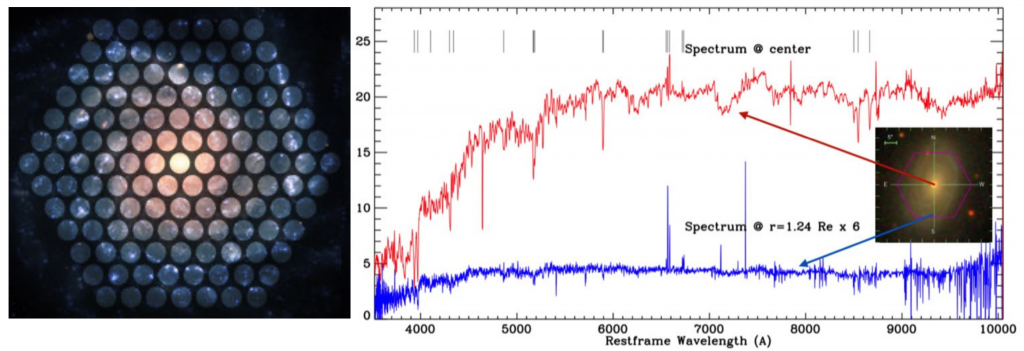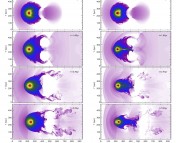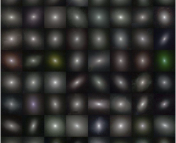
This guest post was written by Liza Sazonova, a 4th year PhD student at Johns Hopkins University. Liza says, “I study how galaxies quench and die, together with the amazing SPOGs team. I look at the structural changes of quenching galaxies and try to figure out what’s causing them. When not coding or looking at galaxies, I like playing board games, climbing rocks, and writing a short novel about Phil the Photon!“
Title: SDSS-IV MaNGA: the formation sequence of S0 galaxies
Authors: Fraser-McKelvie, Amelia; Aragón-Salamanca, Alfonso; Merrifield, Michael; Tabor, Martha; Bernardi, Mariangela; Drory, Niv; Parikh, Taniya; Argudo-Fernández, Maria
First Author’s Institution: International Center for Radio Astronomy Research, The University of Western Australia, Perth, Australia
Status: Accepted to MNRAS. Open access on ArXiv.
Ever since 1926, when Edwin Hubble developed his famous tuning fork, we’ve known that galaxies split neatly into 3 types: spirals, lenticulars and ellipticals. Only spiral galaxies are actively forming stars. In lenticulars and ellipticals star formation is shut down, or quenched, leaving behind featureless red galaxies coined “red-and-dead”. Almost 100 years after Edwin Hubble, the reason for their death is still unknown.
Lenticular galaxies, or S0s, are especially enigmatic. Most quenched galaxies in the Universe are lenticular, yet they are much more poorly studied than their elliptical cousins. They are similar to spiral galaxies in shape: they have a clear galactic disk and a central bulge. However, lenticulars are devoid of any gas, so they don’t form stars. The question is — what killed their star formation?
MaNGA survey to the rescue
Tracing galaxy evolution is challenging: we can’t watch galaxies evolve as it takes millions of years. With careful modelling of a galaxy’s spectrum (stellar population modelling), scientists learnt to infer the history of star formation — and see at least when did the galaxy quench. But we still could not see how did it quench.
Until the MaNGA survey.
MaNGA is an an Integral Field Unit (IFU) instrument that measures spatially resolved spectra, i.e. gathers spectra in many different regions of the galaxy. The authors studied spatially-resolved spectra of 279 lenticular galaxies from the MaNGA survey, and applied stellar population modelling to study where did the star formation quench first to try to understand the quenching mechanism.

The authors measured different spectral absorption lines – Hβ, Mgb and Fe – and used a stellar population model to convert the absorption lines to stellar age and metallicity. They measured average stellar age separately in the galactic bulge and disk. With this data, the team could study if the two components evolved differently.
“Same same but different”
Figure 1 (adapted from the paper) shows the main result: S0s of different masses evolve differently.
Milky Way-like galaxies — 1010 solar masses or more — host very old stars, indicating the star formation ceased long ago. The bulges have formed no stars for 1 billion years, while disks quenched slightly more recently — 800 million years ago.
On the other hand, low-mass S0s only quenched about 200 million years ago. These galaxies have relatively young stars in their disks and even slightly younger bulges.
The bulge structure of low-mass S0s is also different. The team measured concentration of the light in the bulge, or Sérsic index, n. A typical galactic bulge has n~4, as we see in massive S0s. Low-mass S0s, however, have smaller n~2. These are pseudo-bulges that form with a completely different mechanism – discussed in more detail in this astrobite.
A tale of two S0s (as told by the stars)
More massive S0s quenched, on average, a billion years ago. Since the bulge hosts older stars, the central region must have quenched earlier, while the disks still continued forming stars for another several hundred million years. This is called inside-out quenching, when the star formation quenched first in the central bulge, as opposed to outside-in quenching (more on this here).
The classical old bulge in massive S0s hints at a violent story of their evolution. Quenching is expected to have been more rapid and disruptive a billion years ago. The bulge was likely built up by a strong dissipative event: a collision with another galaxy or a collapse of an unstable star-forming disk. After such an event, the gas would be driven into the center of the galaxy, and star formation would quench after a spectacular starburst or AGN event. Watch it happen in a simulated galaxy merger!
On the other hand, the age gradient and the pseudo-bulge in low-mass S0s imply a much more quiet and passive evolution. A typical low-mass spiral galaxy forms stars until it runs out of star-forming gas. Various processes — supernovae or stripping by nearby galaxies and clusters — try to remove this gas. Low-mass galaxies do not have a strong enough gravitational potential well to retain the gas, and so become stripped. Since the gravitational potential is deeper in the center, the bulge was able to hold on to its gas a little longer, leading to slightly later quenching in the central regions.
Visually, S0 galaxies are almost indistinguishable from one another, so it’s especially amazing that the deaths of these galaxies can be so different. High-mass S0s are victims of a violent quenching event, while low-mass S0s quietly retired their star formation. Yet end up looking the same!
We can’t forget this; so we must consider all factors that could play a role in a galaxy’s evolution — its mass, environment, and even the cosmic time it resides in… which makes our job extra difficult and fun!
Featured Image Credit: ESO/P. Barthel
Bite Editor: Abygail Waggoner



